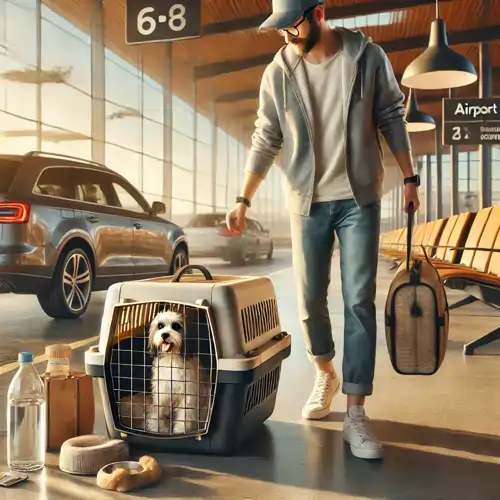Practical Tips for Traveling with Pets: How to Ensure Comfort and Safety
Introduction
Traveling with pets is becoming increasingly popular, however, owners often face problems related to organizing the trip. The main "pain points" are paperwork, ensuring the pet's safety and comfort during the trip, stress associated with transportation, as well as the need to comply with strict regulations when entering other countries. In this article, we have collected practical tips and life hacks that will help reduce the risk of problems and make the trip as comfortable as possible for you and your pet.
1. Document Preparation and Medical Safety
One of the key aspects of traveling with a pet is the correct preparation of all necessary documents.
- Veterinary International Passport (VIP). Before traveling, it is necessary to obtain a VIP with vaccination records. This is a mandatory document both for traveling within the country and abroad.
- Microchipping. All pets must be identified with a microchip (an identification device that allows you to quickly determine the owner's data). If the microchip does not comply with international standards ISO 11784 and 11785, a special device may be required to read it at the border.
- Vaccination. A key point is timely vaccination, especially rabies vaccination. It is important to remember that vaccination must be carried out after microchipping, and there must be at least 21 days between vaccination and crossing the border. For some countries, a rabies antibody test may be required, which must be carried out no earlier than 30 days after vaccination.
- International Certificate and Veterinary Certificate. When traveling abroad, an international certificate confirming the pet's health status is often required, as well as a veterinary certificate (form No. 1) issued by a state veterinary clinic. Preparing all these documents takes time, so it is important to start the process in advance to avoid delays and problems at the border.
2. Ensuring Pet Comfort During the Trip
The trip should be not only safe but also comfortable for the animal. To do this, it is necessary to pay attention to the following points:
- Choosing a Carrier. The carrier should be the right size for the animal and have good ventilation. It is important that the pet can move freely inside, stand up, turn around, and lie down in a comfortable position. Bedding or disposable pads provide additional comfort and can be used to protect the carrier from dirt.
- Preparing Supplies. It is necessary to bring enough food and water. It is recommended to use compact travel water bottles and bowls, as well as avoid overfeeding during the trip to prevent digestive problems.
- Accessories and Familiar Items. To reduce pet stress, it is helpful to bring their favorite toys, a bed with a familiar scent, or other things that create a sense of comfort. This approach helps reduce anxiety during a prolonged stay in an unfamiliar environment.
3. Transportation and Safety on the Road
The choice of transportation method directly affects the safety and comfort of the animal. Let's consider the main types of transportation:
- Traveling by Car. When traveling by car, it is important to make regular stops every 2-3 hours so that the pet can stretch and go to the toilet. Use special carriers or seat belts (for example, harnesses with attachments) so that the animal does not disturb the driver and is securely fastened inside the vehicle. Be sure to check the animal's condition after each stop - make sure there are no ticks or other foreign objects.
- Train. When traveling by train, you should familiarize yourself with the conditions for transporting pets, as they may vary depending on the carrier. Small animals (up to 6-10 kg) are usually transported free of charge in a special bag or cage (approximately 45×30×25 cm), while for larger pets it is necessary to purchase a ticket. Pay attention to the rules of transportation - the animal must be in a cage or carrier, and also be on a leash.
- Flights. Flights are the most difficult type of transportation for pets. Before buying a ticket, be sure to check the transportation conditions with the airline. Small dogs and cats can be transported in the cabin of the aircraft, provided that the total weight of the pet with the carrier does not exceed 8 kg, and the dimensions of the container comply with the established standards. Larger animals are sent in the cargo hold, which requires special attention to the safety and comfort of transportation. Be sure to have all the necessary documents, health certificates, and vaccination certificates with you. If necessary, consult a veterinarian about the use of stress-reducing medications during the flight.
4. Adapting Your Pet to Travel
To minimize stress on the animal, it is recommended to accustom it to the carrier and long trips in advance:
- Gradual Training. Start with short trips by car or train, gradually increasing the travel time. This will help the pet get used to the transportation conditions.
- No Tranquilizers Without Consultation. Do not resort to the use of sedatives without first consulting a veterinarian, as they can negatively affect the animal's health.
- First Aid Kit for your pet. The kit should include neutral soap for washing wounds, disinfectant solution, gauze, bandages, scissors, tweezers, a thermometer, as well as medications for food poisoning and allergies. This kit will allow you to quickly provide first aid in case of minor injuries or ailments.
5. Additional Recommendations for Traveling in Spain
If your destination is Spain, you should take into account a number of specific requirements:
- To enter Spain, it is necessary to have a properly completed veterinary international passport (VIP) with records of all vaccinations, an international certificate, and proof of microchipping.
- When transporting pets on public transport, it is important to follow the rules established for this country, as they may include the mandatory use of cages or carriers.
- In popular destinations, such as beaches or tourist cities, there may be restrictions on the presence of animals. Research local regulations to avoid unpleasant situations or fines.
Conclusions
Preparing to travel with a pet requires careful planning and attention to many details. Processing all necessary documents (VIP, certificates, reports), ensuring the pet's safety and comfort, choosing the right transport, and adapting the animal to travel are key factors in avoiding problems on the road. Following the tips and life hacks provided will help reduce stress, ensure the comfort and safety of your pet, and make the trip successful and enjoyable. With proper preparation, you can enjoy the time spent with your pet and avoid unexpected expenses and unpleasant surprises.








